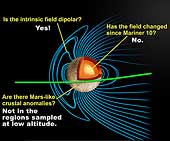|
COMETS EARTH JUPITER KUIPER BELT MARS MERCURY METEORITES NEPTUNE OORT CLOUD PLUTO SATURN SOLAR SYSTEM SPACE SUN URANUS VENUS ORDER PRINTS
PHOTO CATEGORIES SCIENCEVIEWS AMERICAN INDIAN AMPHIBIANS BIRDS BUGS FINE ART FOSSILS THE ISLANDS HISTORICAL PHOTOS MAMMALS OTHER PARKS PLANTS RELIGIOUS REPTILES SCIENCEVIEWS PRINTS
|
Related Documents
Download Options
This depiction of a simulated Mercury magnetosphere shows representations of the distortions of the planetary magnetic field lines (blue) by the solar wind. Mariner 10 data showed the first evidence for a magnetic field at Mercury, an unexpected result. The equatorial pass of MESSENGER during quiet solar conditions provided better data than were available from Mariner 10. MESSENGER saw an internal magnetic field that is well described by the field from a dipole nearly aligned with the planet's spin axis (dipole tilt ~ 10°). This geometry is similar to that observed by Mariner 10 during its first flyby. The field strength is weaker by about one third than that detected by Mariner 10 during its third (and last) flyby, owing primarily to the difference in trajectories (Mariner 10 flow directly over the magnetic pole where the field strength is greatest). When corrected for our best estimate for the external field, the MESSENGER observations and the two Mariner 10 passes are consistent with very similar solutions for the mean planetary magnetic dipole. The dipolar field is consistent with an active electrical dynamo in which the magnetic field is produced by electrical currents flowing in an outer core of molten metal. The observations do not yet allow us to identify whether a small secular variation may have occurred, determine higher order structure in the field, or assess whether crustal magnetic signatures may be present at other longitudes. A combination of the next two flybys and the orbital phase of MESSENGER's mission will be required to sort out all of these possible effects. |
